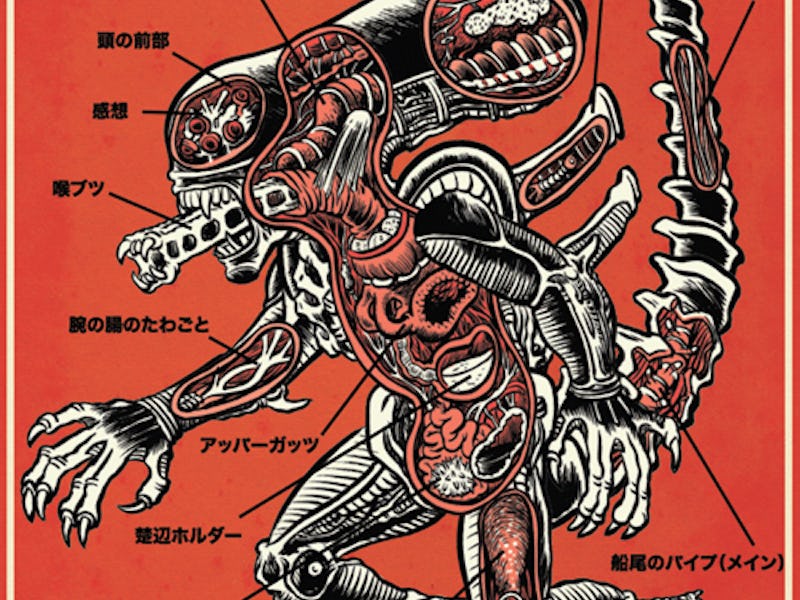A Complete Guide to 'Alien' Xenomorph Biology
"A survivor, unclouded by conscience, remorse, or delusions of morality"

The Xenomorph, also known as the titular “Alien” in the Alien film franchise, was designed by Swiss surrealist H.R. Giger in the late 1970s. His painting, “Necronom IV”, was used as concept-art inspiration in pre-production for Ridley Scott’s film Alien. In 1980, H.R. Giger co-won an Oscar for his work on film in Visual Effects. He shared the honor with Italian SFX designer Carlo Rambaldi, who crafted the xenomorph’s head and body during Alien’s production.
Though xenomorph biology changed and expanded throughout the franchise, many parts of its structure remained the same. The xenomorph is, as the android Ash (Ian Holm) says in Alien, “a perfect organism,” with a “structural perfection matched only by its hostility.” He adds in the film, “I admire its purity. A survivor, unclouded by conscience, remorse, or delusions of morality.” It is a parasitoid, rather than a technical parasite, because it spends a good portion of its life untethered to a host. It is also an arthropod, similar to a cicada or shrimp, with a segmented body, jointed appendages, and a thick, protective exoskeleton.
Social structure
It’s implied in the film that xenomorphs are eusocial; but the Queen’s vision in Aliens confirms it. Xenomorphs protect a central female creature to ensure the continuation of their species. Though a large Queen births young xenomorphs still encased in warm eggs, all xenomorphs display feminine and masculine traits, according to H.R. Giger’s design.
Predatory Tactics
The adult xenomorph is a solitary predator and values the destruction of its prey over cooperation with its kind — though in some cases, as depicted in long sequences, the creatures move as a pack. Rather than feed on humans, xenomorphs often incapacitate prey and transport them to the hive to impregnate the still-live humans with their young. If a particular human reacts violently or doesn’t make a suitable host for the growing young, the xenomorph simply kills that human and moves on.
In Alien Evolution, a doc. charting Alien’s creative process, screenwriter Dan O’Bannon confirmed that the alien’s use of humans as living hosts was intended to disturb male viewers. The alien life cycle, O’Bannon explained, is not a straightforward depiction of female human pregnancy, but of “cross-species homosexual oral rape”.
Line producer Ivor Powell affirmed in an interview that the xenomorph’s primary objective was to inspire sexual horror in the viewer. Based on its physical make-up, Powell said, “it could just as easily fuck you before it killed you, [which] made it all the more disconcerting.”
The DNA Reflex
The xenomorph, gestating inside its living host, develops physical traits similar to its host by studying its cellular makeup. Aliens formed inside humans, for example, burst from human chests and form a bipedal structure, walking on their hind legs like humans would. The “predalien”, on the other hand, formed inside a Yautja (the titular monster from Predator), has Yautja-like characteristics. Also, the xenomorph formed using Ellen Ripley’s DNA in Alien: Resurrection has a humanoid skull and exhibits an emotional connection to its mother in a way pure xenomorphs don’t.
Basic senses
According to Alien comics and novelizations, Lasalle Bionational, a fictional research facility, has carried out intricate studies on xenomorph behavior and consciousness. Though xenomorphs don’t have humanoid ears, their long heads are equipped with sensitive segments of flesh which pick up on sound vibrations. Their visual organs are rudimentary according to human scientists in Alien canon, because xenomorphs don’t rely on sight while hunting.
Additionally, xenomorphs don’t give off body heat, and they typically maintain a temperature similar to their environments.
Life cycle
As described by the Alien vs Predator fan-generated wiki:
The Xenomorph life cycle is a complex process comprising several distinct stages. The creature begins its life as an Ovomorph, or Egg, laid by a Queen, which hatches a parasitoid larval form known as a Facehugger, which in turn “impregnates” a living host with an embryo known as a Chestburster. After a gestation period of several hours, the Chestburster erupts violently from the host’s chest, resulting in the death of the host. The Chestburster rapidly matures to an adult phase (within a matter of hours), shedding its skin as it grows and replacing its cells with polarized silicon.
The colloquial terms “facehugger” and “chestburster” originated, of course, from the events of Alien, which visually outlined a xenomorph’s complete lifecycle in detail.
Secretions and Liquids
Xenomorph blood is highly acidic, and injuring a xenomorph allows its inner secretions to burn through human flesh and industrial metals. Though dialogue in Alien calls the blood “molecular acid,” this phrase is actually a tautology, as all acids are made up of molecules. For decades, fans have tried to reason out what a xenomorph’s blood might actually contain, but there has been no canonized confirmation of a molecular structure.
Editor’s note: an updated guide to xenomorph biology was published on May 22, 2017.